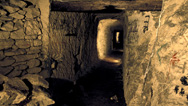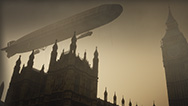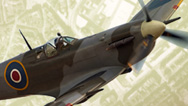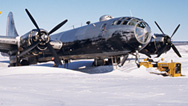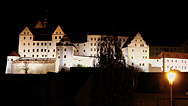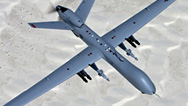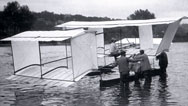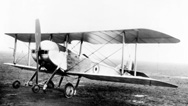
First Air War
How did fighter planes evolve from rickety biplanes to deadly machines during WWI? Airing October 29, 2014 at 9 pm on PBS Aired October 29, 2014 on PBS
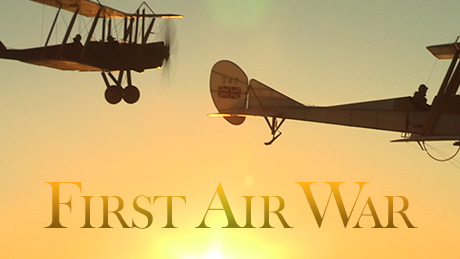
Program Description
Transcript
First Air War
PBS Airdate: October 29, 2014
NARRATOR: World War I was the first time in history that airplanes joined the battle. Almost as soon as the first shots are fired, a high-speed race for domination kicks off in the skies above the trenches, a high-ground vantage worth fighting and dying for.
A century after World War I, the actual experience of flying these planes into combat has been lost to history, until now. At a quiet airfield in New Zealand, a small band of aviators and engineers is building exact replicas of World War I fighters and putting modern-day pilots into the open cockpits to experience firsthand what it must have been like to fly above the trenches of the Western Front.
Here, World War I fighters are being built, down to the finest detail.
GENE DE MARCO (The Vintage Aviator): We focus on creating stuff that doesn't exist. We have the ability to compare those airplanes by using the real thing, essentially. That's the only way you can get that sight, the sound, the smell of these airplanes.
NARRATOR: They work from the original designs.
NIC LARSEN (The Vintage Aviator): And there will be somebody's name, and it'll have a date 1915, 1914. And that sort of really hit home. I thought, "Wow!"
NARRATOR: With no World War I fliers still alive, this work brings to life the pioneering designs that helped change the course of the war and meant the difference between life and death for thousands of young men.
PETER HART (World War I Tactical Historian): War is an amazing catalyst. It forces progress, 'cause if you do not march forward, you will lose.
NARRATOR: Between 1914 and 1918, aviation designers turn the airplane from eccentric novelty to decisive weapon. They invent aerial warfare.
GENE DE MARCO: The fact that we can get these airplanes in the air is phenomenal. We can go back in time.
NARRATOR: First Air War, right now, on NOVA!
World War I, one of the bloodiest wars in history: millions die in the cruel stalemate of trench warfare. The desperate effort to break the deadlock leads to the most rapid advance of military technology in history, when a new invention enters the fray: the airplane.
In just four short years, an evolving array of machines takes to the air: from the BE.2 observation plane, with a top speed of 72 miles per hour; to faster, nimbler fighters like the British SE.5A, with mounted guns and the ability to shoot other planes out of the sky; and the German Pfalz D.III.
By 1918, many of the essentials of fighter aircraft were in place. How did this happen?
In the quiet town of Masterton, New Zealand, a unique experiment is taking place. Here, they build World War I planes exactly as they were 100 years ago, down to the smallest detail. The goal is to understand what it was like to fly and fight in these fragile war machines.
GENE DE MARCO: I got into aviation very early on. I restored my first airplane when I was about 15, learned to fly at that age, flew halfway around the United States when I graduated high school.
NARRATOR: Gene de Marco, an American, living in New Zealand, heads an outfit called The Vintage Aviator. This group is dedicated to keeping history alive by recreating these antique flying machines.
The work demands painstaking research, from hunting down original blueprints to sourcing authentic parts and materials.
NIC LARSEN: Some planes, we may have a total amount of drawings, other planes we might miss, you know, part of the wing or something like that, and in that case we often reverse-engineer a component we may have found around the world.
NARRATOR: They're trying to decode and document the leaps in technology that these new weapons of war represent.
NIC LARSEN: We're sort of keeping history, you know, keeping up with history, making sure that we don't lose the past, basically.
GENE DE MARCO: As much as we had the drawings, we didn't have that assembly manual, that process manual that told you this is how you make the part.
These airplanes were essentially hand-produced, and the fact is they're organic. They're built out of, you know, timber and fabric and cord and stuff like that. And all of those skills had to be reproduced. We had to find craftsmen that could do that kind of work.
ROGER POSTHUMA (The Vintage Aviator): We're constantly impressed by the machining skills back then. When you look at the complexity of the crank case, the casting, it's very, very clever.
NARRATOR: In World War I, even small differences in aircraft performance could mean life or death for the pilots who fly into combat, potentially altering the balance of air power in the skies above the Western Front.
August, 1914: The armies of Germany range against Britain, Belgium and France. Nearly three-and-a-half-million men are thrown into combat.
But military leaders are undecided what role the recently invented airplane will play in the war.
PETER HART: Every major power was preparing for war, and part of that meant looking at this new idea, this new concept, andâ¦"What are we going to do with airplanes?"
NARRATOR: At the outbreak of war, powered flight is still a lethally dangerous pastime. Planes are so flimsy that a 20 mile-per-hour gust of wind could flip them over.
GENE DE MARCO: They were often referred to as kites, and they did, they handled like kites. They were blown around by the wind.
Even we have difficulty with some of these airplanes. They have unusual handling characteristics, affected by wind. The performance is terrible compared to some modern airplanes.
NARRATOR: And many top brass want nothing to do with these new flying machines. Some even refer to them as "useless contraptions."
TREVOR HENSHAW (Aviation Historian): The people at the top were certainly not convinced. They'd seen evidence that the aircraft could perform jobs for them. But it's very difficult for something that is in few numbers, unreliable, somewhat dangerous, to really be able to prove what direction it could take itself and take the army.
NARRATOR: War has always been waged without airplanes before, and some thought war would be waged without airplanes now.
PETER HART: I mean, one of the most skeptical of the generals was undoubtedly Sir John French, who just couldn't think of why they were necessary. He didn't see the point. They were too frail, too inconsequential, in the scheme of things.
NARRATOR: But others are determined to prove their worth. At the outbreak of war, the British Royal Flying Corps, the R.F.C., has just over 100 airplanes. Four squadrons fly to France to join the conflict.
In the early days of the First World War, armies on both sides advance through open fields and towns. Their commanders can see no further than the hedgerow or hill in front of them. To find out what the enemy is doing, they are forced to send scouts on foot or horseback, straight into lethal artillery and machine-gun fire, deployed on an industrial scale for the first time. So barely a week into the fighting, the so-called "over-rated contraptions," invented just over a decade before, enter the war.
PETER HART: It's amazing to think that it's the first time people have ever flown. It seems unbelievable that in just a few short years they're actually going to war.
NARRATOR: Despite all the early doubts, war in the sky soon becomes a grim reality. While the Germans work on their own aircraft, the British develop the BE.2. This stable, easy-to-fly airplane is the work of legendary designer Geoffrey de Havilland.
In New Zealand, the team has built an exact reproduction of his trailblazer. Accurate down to the last detail, it gives them an authentic 1914 flying experience.
GENE DE MARCO: Here we are, at home in a BE.2C.
NARRATOR: This lightweight biplane has two sets of wings, to generate lift and provide structural rigidity. The pilot sits in the rear, an observer, up front.
GENE DE MARCO: Every airplane sort of has its own personality. You get a real taste for what it's like to fly these old airplanes.
NARRATOR: It is unarmed, and its maximum speed is only 72 miles per hour. In a strong headwind it is almost static, literally floating.
GENE DE MARCO: These early BE.2Cs were strictly used for observation in the beginning of the war. They weren't armed in any way, they weren't armored in any way. And they were slow, fragile airplanes that could, you know, barely get aloft with two people on board.
NARRATOR: De Havilland designed the airplane for spying on the enemy below.
PETER HART: In the early days, it was really just the pilot, the observer and their trusty notebook and their pen. And they'd go up, and they'd have a map on, strapped to one knee, and they'd have a notebook on the other.
NARRATOR: With no radios to report their observations back to base, this is a primitive operation.
PETER HART: They'd draw a diagram on their knee, with notes of what they could see, and then fly over the nearest Army headquarters and just drop it, a message bag. And that was all it was. That's all there could be in the first couple of months of the war.
NARRATOR: Basic as these sketches are, they mark a crucial step forward in military intelligence. For the first time, the army has an eye in the sky, and its advantages soon become obvious.
With the ability to see the location of trenches and targets from the air, pilots are able to give information to gunners on the ground.
TREVOR HENSHAW: These aircraft really came into their own, in cooperating with the artillery. They were able to be, in effect, missile guidance systems.
NARRATOR: This information helps the artillery progressively adjust their aim, as they zero in on the target.
PETER HART: As the war went on, the role of the Royal Flying Corps, sort of, slightly mutates. They become less the eyes of the whole army and very much more become the eyes of the artillery.
NARRATOR: But communicating targeting information quickly is a challenge, so airplanes are soon equipped with Morse code radio. Now the airmen can see where a shell lands and send word instantly to troops on the ground. The guns can then be adjusted and then fired again, followed by further adjustments ordered by the airborne observer.
PETER HART: And then when you actually hit the target you send the signal that says "go ahead," at which point the whole battery will open fire to destroy, and that's when the mayhem starts.
NARRATOR: A few months after the start of the war, the fronts have been established. Trenches stretch from Switzerland to the North Sea. This deadlock also means change for the Royal Flying Corps. They'll need faster, more agile planes, because these new defenses are manned by troops looking up to the skies and aiming artillery that will soon be able to reach those planes.
1915: The slaughter of the Western Front is well underway, and hundreds of thousands of men are dug in. The Royal Flying Corps is under pressure to help break the deadly stalemate of trench warfare. Mapping these complex battlefields by drawing sketches is no longer good enough.
PETER HART: The thing about sketches is they're great in a war of movement, when you're just, you know, putting a big arrow on a map showing which way things are going. It's very different when trenches are established. And then you really want to know exactly where the trenches are.
NARRATOR: Trench warfare means that, for the first time, the battlefield is static. It is gridlock. Machine gun nests are dug in and fortified; permanent communications lines are built; and barbed wire is now strung out in front of the trenches.
It's more crucial than ever to map enemy strongpoints and hidden gun positions. The solution lies in another new technology: aerial photography.
PETER HART: If you take a camera up and take a photograph, then you can come back, bring it back, develop it, and then it could be taken to headquarters and you can collectively examine it and determine exactly what's on the ground.
You can see where the machine guns are, you can see where the German artillery batteries are, you can see where the communication trenches are, where the dugouts are, where the headquarters are.
NARRATOR: For the Royal Flying Corps, the growing demand for photographs means spending more time over enemy trenches. But spying from the sky has always been a dangerous job.
The first casualties come only three weeks after war is declared. Pilot Vincent Waterfall and his observer, Charles Bailey, are shot down while spying on German troop movements in Belgium.
Aviators are increasingly a priority target. They have to be prevented from getting home with their information.
TREVOR HENSHAW: The level of anti-aircraft fire was such that you would expect to pretty much have it on every single mission: completely surrounded by bursting brown-white clouds of smoke, filled with red hot bits of iron.
NARRATOR: The linen and wooden planes offer no protection.
GENE DE MARCO: These young guys had to be really brave. They were protected by, essentially, a wicker seat and fabric. You can poke a sharp stick through the side of these airplanes. They weren't exactly armored.
NARRATOR: The BE.2, the standard British observation plane, is not designed to carry unwieldy cameras.
GENE DE MARCO: Obviously, in this airplane, it's quite obstructed. I've got wires, I've got the landing gear in the way, of course, lower wing is in the wayâ¦not ideal.
NARRATOR: Two pilots from the team are about to experience this firsthand. They want to see just how hard it would have been for a First World War aviator to get usable photographs.
Bevan tries to brace the camera, but, in the 70-mile-per-hour slipstream, the photos are blurred. And without a decent overlap the individual photos are useless.
So de Havilland's engineers come up with a simple solution. Gene's team makes the same changes.
GENE DE MARCO: These cameras were often fitted right to the side of the airplane, with a mounting bracket that allowed it to be mounted straight down, right here, quite convenient, because the wing is actually cut out to allow the pilot to look straight down.
NARRATOR: To improve the BE's performance, it's upgraded with a 90-horsepower engine. The wooden landing skids, designed to stabilize the plane on the ground, are thrown away to save weight. New, more efficient wings increase speed and lift, and streamlined steel wires replace drag-prone woven cables.
GENE DE MARCO: The combination of all these small advances, like the use of streamlined wires, that's what led to huge steps forward in aircraft technology.
NARRATOR: Gary and Bevan now switch to the later BE.2F model, which has a fixed camera mount. This time the pilot, Gary, will photograph the land below, and Bevan will act as his observer.
Counting down intervals for each exposure will help them capture a complete mosaic, but only if Gary can fly the plane steadily as he takes the pictures. Their struggle to take photos in midair is giving Gary and Bevan an appreciation of what those early pilots went through.
GARY (The Vintage Aviator): Imagine doing that, though, and getting shot at at the same time. It's pretty much almost a guaranteed suicide mission.
BEVAN (The Vintage Aviator): It would definitely be risky. That's for sure.
NARRATOR: The team looks at the results of both missions. It's clear that the fixed camera produced the better shots. The BE.2's camera mount means that the photographs can be easily put together to form an aerial view of the entire area.
GENE DE MARCO: There's a significant advantage to the modifications made to the airplane, the development of the airplane.
BEVAN: Absolutely! Yeah.
NARRATOR: The mounted camera transforms the fight at ground level. For the first time, officers have an invaluable aerial picture of the entire enemy line. But making systematic photo maps of the trenches means flying slowly and in a straight line, making the plane an easier target.
PETER HART: If you were flying in the straight line that you had to fly to take a series of photographs, then a German anti-aircraft gun was a real danger. They could tell exactly where you'd be. They could shoot ahead of you, and they could get very close to you.
NARRATOR: But while the fliers are fair game for the troops on the ground, pilots on opposing sides see themselves as fellow aviators. Firing at another airman is strictly off limits. But this gentlemen's code can't last. It isn't long before planes become targets, not just for the ground soldiers, but also for enemy airmen.
PETER HART: They have almost no choice of weaponry. They take up the weapons they have to hand; and to hand, the most obvious is the revolver. Now, the average British officer cannot hit a barn door on the ground at twenty yards, because they jerk about so much, but the British army does have an accurate weapon. It has the Lee Enfield, the rifle. It's brilliant, it's accurate, but the problem is when you're in the open cockpit again.
NARRATOR: The team's plan is to find out just how hard it is to hit a target from these moving platforms.
GENE DE MARCO: We're going to use these laser rifles, so it's not nearly as dangerous as it was in the First World War. You know how valuable the airplanes are. We don't want to take any chances.
NARRATOR: The laser rifles are loaded with five shots per magazine, the same as with the standard issue Lee Enfield rifle. Each shooter wears sensors, so they'll know if they've been shot.
Barely over eighteen, Bevan and Josh are the same age as many of the young pilots in the Great War. But they are in the safe hands of veteran pilots John and Gene who have thousands of flying hours of experience.
In World War I, some pilots were sent up after only a few weeks of training.
Now at altitude, the aircraft separate and position themselves for the fight. The planes will fly towards each other three times. Any direct hits will be registered on the sensors.
Right from the start, engine oil already coats the camera lens. It's also getting on Bevan's goggles.
The planes come within a short distance of each other, with a closing speed of 120 miles per hour.
GENE DE MARCO: Did we get him?
NARRATOR: With the propeller, struts and wires in the way, the gunners find it awkward to take aim.
GENE DE MARCO: I guess we're still alive!
BEVAN: That's really hard! You got oil and stuff on your goggles. You can't see anything!
JOSH (The Vintage Aviator): Then you got the prop arc, and you got the streamlined wires and the struts. It's near impossible.
GENE DE MARCO: I mean, we fly these airplanes a lot and do displays and stuff, but when you're actually setting out to, you know, accomplish a specific task like this? You don't realize how difficult it is.
NARRATOR: Thirty shots are fired between the two observers, and not one hit on target.
BEVAN: Whose idea was it to wear this during the war?
NARRATOR: A hundred years ago, the results were often the same. Those experiences survive in recordings made years after the war.
S.S. SAUNDERS (WORLD WAR I, ROYAL FLYING CORPS, OBSERVER/AUDIO RECORDING): The arms issued to the Royal Flying Corp personnel at that time was a rifle. If you saw an enemy aircraft then you took this rifle out, you would let him have it, best you could. You had to be very careful not to shoot any of the controls away.
LIEUTENANT ARCHIBALD JAMES (WORLD WAR I, ROYAL FLYING CORPS/AUDIO RECORDING): We met a German at about the same altitude as ourselves. I put up my sights and fired six deliberate shots. I was miserable that I didn't apparently hit him at all. I have no doubt I was miles away. We later on learned that with a vibrating platform the effective range was rarely exceeding 50 yards.
NARRATOR: Only one weapon promises to be effective at hitting a plane in mid-air, the same weapon used for slaughtering millions of infantrymen on the western front: the machine gun. The machine gun had turned warfare into industrialized killing. A single Vickers or Lewis gun could fire nearly 500 rounds a minute.
But how to attach these heavy and powerful weapons to a fragile airplane creates a fresh problem for the engineers.
GENE DE MARCO: I think, after looking at the BE.2s, the early progression: that BE.2C that we have, without any guns mounted on it at all; and then the next step was the BE.2F, where they mounted a few Lewis guns on those candles mounts, where you could fire the gun around, but you had to be careful that you weren't shooting your own airplane. You had a very narrow arc where you could fire forward or maybe to the back. That was very limiting for defending yourself.
NARRATOR: The only practical way to use a machine gun in midair is to turn the whole plane into a weapon.
GENE DE MARCO: Having a fixed gun and just aiming the airplane was determined the best way to go. If the pilot could actually point the airplane at the enemy and chase him and actually pull a trigger and shoot, that, that was ideal.
NARRATOR: It is now 1915, one year into the war. Aircraft and the intelligence they carry out, are proving critical to the war effort. Both sides want the other stopped.
Shooting down a plane relies as much on luck as on judgment. It's one thing to mount a forward-facing machine gun to a plane's fuselage. The problem is to fire the gun without shooting the plane's propeller blades. Whichever side does this first will rule the skies.
TREVOR HENSHAW: The problem with trying to fire through the arc of the propeller is that the bullets are coming out of the machine gun at a particular rate; the propeller, which is made of wood, is flying around, passing the line of fire at a different rate; and anyone who's done a little bit of physics about these things will know that there's a point at which the bullet is going to hit the propeller.
NARRATOR: Now it's become the key engineering challenge: how to mount a machine gun onto an airplane without shooting up the propeller.
The first breakthrough comes thanks to a French aviator. Roland Garros has raced planes before the war and gained fame for flying across the Mediterranean from Southern France to Tunisia.
GENE DE MARCO: Roland Garros, one of the first guys to do such a thing, mounted a fixed gun, and firing through the propeller of this tractor airplane—the engine in the front—mounted little wedge-shaped metal blocks to the back of the propeller, just to deflect those bullets.
TREVOR HENSHAW: It's undeniable that Garros was a brave man. When you think that what would happen with a bullet hitting one of these deflector blades, it is a very brave man who'll sit a meter, two meters behind these deflector blades. The clue's in the word, there are bullets going to be deflected back into you.
NARRATOR: Garros uses his reinforced propeller to make three kills, before enemy ground fire forces him to crash land behind enemy lines.
PETER HART: Well, when Garros was shot down, he tried to set fire to his airplane, and he managed it, but he didn't destroy all of it. The Germans could see what he'd been up to.
NARRATOR: Twenty minutes after his capture, the Germans take this photograph, and they hand his system to a young Dutch aviation designer, Anthony Fokker.
The German military has also been looking for a solution to the shooting problem. Twenty-four-year-old Fokker's name is to become synonymous with First World War aviation. His pioneering designs will provide the German air force with more than 3,300 airplanes over the course of the war.
But it could have turned out differently. Fokker is from Holland, a neutral country. Before the war he offered his services to the British Army, but the British turned him down.
PETER HART: Later on, when you look at what he achieved for the Germans, then there is a slight feeling of "if only he'd been working for us," because he clearly was very good at putting together an expert team of designers, and he got the job done.
NARRATOR: What Fokker is about to deliver will tip the balance of power in the air in Germany's favor. Fokker's interrupter mechanism synchronizes the gun's firing rate with the engine so that the bullets fly through the gaps between the spinning propeller blades. But when the propeller passes in front of the muzzle, a mechanism blocks the trigger of the machine gun and stops it from firing.
Fokker fits the mechanism to his own aircraft design: the Eindecker. The Eindecker monoplane is not an impressive flying machine. Its maximum speed is only 87 miles per hour, and it can stay up for only an hour and a half.
GENE DE MARCO: They weren't great by any means, as far as their flying capability, but they had this one technological advancement, which was the interrupter gear, which allowed them to score numerous victories. They became a deadly tool to shoot down the enemy.
PETER HART: It would dive down, out of the clouds, out of the sun, onto an unsuspecting British plane, and then it would fire through its propeller, take them by surprise and shoot them down, before they knew what was happening.
NARRATOR: The Fokker Eindecker marks a new chapter in aerial warfare, the birth of the first fighter aircraft.
In the few months after Fokker's new plane is introduced, 82 Allied planes are shot down; 74 lives are lost. It is a time that becomes known as the "Fokker Scourge."
PETER HART: As ever, with these things, the press and politicians had a field day. This was the "Fokker Scourge," this was. Why hadn't we foreseen this? Why weren't we doing something about it? Why wasn't it sorted out now? Well, the answer is because it takes between one and two years to design an aircraft. You can't just magic them up.
NARRATOR: The Eindecker challenges the Allied effort to spy freely over the trenches. Tens of thousands of lives rely on this aerial intelligence.
PETER HART: For the soldier in the trenches, the Royal Flying Corps was a godsend, a literal godsend, because without them the German artillery, the German machine guns would slaughter them, when they went over the top. It was as simple as that.
NARRATOR: The commanders know that if they don't come up with a solution they will lose the air war. But with no immediate rival to the Fokker's interrupter mechanism, the Allies fall back on a different approach.
GENE DE MARCO: Just looking at this airplane, it's quite a bit different, but the most notable difference is the engine being mounted in the back. So it couldn't have a traditional fuselage, and they rigged it with these twin booms that support the whole tail on, sort of, a very flimsy structure that's all wire-braced with these R.A.F. streamline wires.
NARRATOR: In this strange-looking design known as a "pusher," the propeller pushes the plane through the air. Though it looks unconventional, the front of the plane presents no obstacle to unimpeded machine-gun-fire.
GENE DE MARCO: The two machine guns are mounted in the front of the nacelle, and they could fire unobstructed, directly ahead. So, shooting through a propeller, they didn't have to worry about interrupter gear.
NARRATOR: In building these machines, the team occasionally finds flaws that they might be tempted to fix.
GENE DE MARCO: There's always a danger to improving on an original design. If we produce it exactly like it was in the day, I shouldn't have anything to worry about; if it worked then it should work now. The problem with changing things or trying to improve on a design, you know, sometimes a weak link is left in the chain, and it allows parts to wear out, let's say. If you increase the strength of that, it moves the weak link somewhere else. And instead of a minor failure or something wearing out, that weak point might move to something that now creates a catastrophic failure. And we rely on the experience of the guys back in the day, because, heck, they made thousands of these, and they were flown in combat conditions. They must be okay.
NARRATOR: This reproduction FE.2B, a so-called pusher, is one of two built by the New Zealand team, and they're the only examples flying today, giving them a unique perspective.
GENE DE MARCO: The guys up front have to make sure they don't have anything loose on their bodies, clothing, helmet, goggles that could fly back and hit the propeller. All the shell casings that were discharged from the guns were in danger of going through the propeller and damaging it, so they had to come up with another solution and that was bags, such as these, to collect the spent cartridges.
NARRATOR: In early 1916, six months after the start of the Fokker scourge, pusher designs like the FE.2B are introduced to the Western Front. The impact is almost immediate. The air war begins to swing the Allies' way.
Pusher aircraft arrive just in time for a massive new British Army offensive. One-hundred-twenty-thousand troops gather to attack the German trenches at the Somme River, in France. But the first day of the land offensive is a disaster, the single worst day in the entire history of the British army then or since, with over 50,000 casualties. It could have been much worse, had the Allied pusher not dominated the skies.
PETER HART: During the first two or three months of the Somme, the British had control over the battlefield, which allowed them complete freedom of photographic reconnaissance and artillery observation. This was extraordinarily bad for the Germans, who suffered a great deal more than they otherwise would have done. So this is an important thing. Control of the air does matter, and it affects the men on the ground.
NARRATOR: And air support becomes even more crucial during the second stage of the Somme battle. Aircraft observers have noticed a new, elaborate German trench system in the exact section the British are planning to attack. Thanks to this intelligence, the push is redirected and thousands are saved.
But the Germans have been working on a new secret weapon, an airplane design that is about to draw the Allied airmen into their own version of the Somme.
GENE DE MARCO: They say that the designer watched fish swimming in a fishbowl to come up with that streamlined fuselage.
NARRATOR: Designed from scratch and built in less than six months, the Albatros, is a highly innovative design. By building an exact reproduction, Gene and his team have discovered the lengths the Germans went to to achieve even the smallest performance improvement.
MALCOLM FRAZER (The Vintage Aviator): This whole panel, here, is made up out of three separate pieces, each individually steam-bent, and then they're laminated together, or scarfed together, through here—60 millimeters of a scarf-join, so they can get that whole form of one panel. It's all glued up as one piece and then glued to the plane.
GENE DE MARCO: This beautiful Albatros D Flyer V, is covered with a screen-printed lozenge design. The fabric itself, the linen, is printed in this colorful pattern, which, it turns out, is an effective camouflage. But in addition to being an effective camouflage, it also turns out that it requires very little dope, the coating that waterproofs it and actually shrinks it tight.
Things like this, discovered by building the airplane itself, I mean we found out the weight savings were significant. It's that experience that we love, discovering certain technological advances that you wouldn't know otherwise, unless you built one of these airplanes.
TREVOR HENSHAW: The key element was the fact that it had two machine guns. It had twice the firepower of anything else in the sky.
NARRATOR: This enhanced firepower helps usher in a new kind of aerial warfare. Now, the Albatrosses hunt in packs, and dogfights, sometimes involving dozens of dueling aircraft, begin.
Engine technology also takes a leap forward, with more efficient and powerful designs that can carry bombs as well as machine guns. It's only a dozen years since the first powered flight, and many of the elements of modern aerial warfare are in place.
In 1917, the U.S. enters the war without having a strong aviation industry, so when American pilots eventually arrive at the front, they fly French planes.
In a new spring offensive, close to the French town of Arras, the battle starts, with the Germans in control of the skies. The British pusher is no match for the Albatros. Without intelligence from above, the British troops on the ground risk another massacre. The British army's solution is to swamp the front with a huge number of planes: 25 squadrons; 365 aircraft in total.
The Germans have merely ten squadrons, but they have the Albatros.
PETER HART: So, what they do is they carry on flying their missions, they carry on doing everything the artillery and the army want them to, and they suffer the casualties as they come. It's murderous. They go up, if they encounter the enemy, they're going to be shot down. Many of them knew that they were up there for other people. They fully understood their role. They knew they were dying for their country, and they carried on doing it. It's a particular form of sacrifice that I find quite inspirational.
NARRATOR: In supporting the troops below, the British lose two-thirds of their aircraft. The Royal Flying Corps gives the destruction a name of its own: "Bloody April."
But despite the heavy casualties, British pilots persevere and the intelligence still gets through. When British troops go over the top, they meet little opposition. Aerial reconnaissance has ensured that the Germans guns are silenced. Although their losses have been horrendous, no one now doubts the importance of air power.
But the Germans still have the superior machines. The pressure falls on the government's Royal Aircraft Factory to come up with an improved fighter that could be a match for the deadly Albatros.
PETER HART: The Royal Flying Corps is right at the center of army plans. They have to do their job. If they don't, people on the ground will suffer, they'll die. It's crucial.
NARRATOR: Two British designers, based in Farnborough, John Kenworthy and Henry Folland, are working on a breakthrough fighter. Called the SE.5, they design it to be fast, sturdy and armed with a brand new interrupter gun mechanism, but its development is not going as planned.
In January, 1917, the Royal Flying Corps' chief test pilot, Major Goodden, is killed while flying an early prototype. Pilots' feedback suggests the seating position is too high, the windscreen too tall and the engine too underpowered.
The pressure on Kenworthy and Folland is ratcheting up.
PETER HART: I think everyone in the aviation industries back, back at home, realized the importance of what they were doing. They are on an escalator that they cannot get off. And if you make a mistake, you can have an aircraft that is completely useless. It's a difficult business, and everybody's very aware that if they make mistakes, then people will suffer.
NARRATOR: A new, improved version, called the SE.5A finally arrives at the front in June, 1917, and it is transformed.
GENE DE MARCO: You get into the SE.5 and, in all honesty, if you didn't know what airplane you were getting into, you'd swear that that airplane was a thirties or even a forties design and was really a fighter to be reckoned with.
NARRATOR: It exceeds all expectations. This ruggedly built fighter is the fastest airplane of the war, but its ultimate test will be in battle. The British SE.5A and the German Albatros will face off in fierce duels over the trenches.
In New Zealand, Gene de Marco and his colleagues have built an exact replica SE.5A.
GENE DE MARCO: These airplanes were loved by the pilots who flew them. They were easy to fly, they were extremely reliable: powered by a 180-horsepower Hispano-Suiza engine; fitted with a single Vickers gun in the fuselage, firing through the propeller, synchronizing right here; and another Lewis gun, mounted above the wing.
NARRATOR: Opposing it will be the German plane, the formidable Albatros.
GENE DE MARCO: Plywood fuselage, all molded, very few metal fittings on this airplane. Easy to manufacture, once you had the tooling for it; reliable Mercedes engine, six-cylinder in-line, 180-horsepower, dual Spandau machine guns—pilot could look right down the guns—easy to aim.
NARRATOR: The team can now fly these machines in a dogfight. Only by pitting them head to head can we see which is the superior fighter plane.
Pilot Andy's challenge is to keep the British SE.5A on the tail of the German Albatros for two minutes. It has speed, strength and maneuverability. But the streamlined Albatros, piloted by Gene, is also a close match for the SE.5A.
GENE DE MARCO: It's not a comfortable airplane, like the SE.5 is. All the hot air and oil and grease and water that come off the engine goes in the pilot's face.
NARRATOR: Despite Gene's attempts to shake Andy off, the SE.5A's power easily keeps it on the tail of the German Albatros. It's over 100 pounds lighter and has a sharper turning radius. Flying one against the other, there is little doubt which performs better.
GENE DE MARCO: I didn't stand a chance against the SE.5. There's no way. I couldn't keep up. You could outturn me without a problem.
ANDY (The Vintage Aviator): It's got the same speed as the Albatros, but more maneuverable. And it's just easier to fly, isn't it?
NARRATOR: The British designers produce other deadly fighters besides the superlative SE.5A. In June, 1917, the Sopwith Camel, smaller, but equally well-armed, arrives at the front. This plane has a top speed of 115 miles per hour, slower than the SE.5A, but is much more maneuverable, and can climb higher, allowing pilots to perform surprise diving attacks on enemy aircraft.
GENE DE MARCO: The Sopwith Camel has a sports-car-like performance. It's really a true fighter.
NARRATOR: Now, finally, with the Sopwith Camel and SE.5A, the Allies have two fighters that are better than the Albatros. The tide of the air war is swinging in the direction of the Allies.
GENE DE MARCO: There's a great advantage to having these airplanes that are accurate reproductions or truly original airplanes. 'Cause we can go back and compare some of the things we've read about, some of the things we have all read about, and having the actual airplane and actually being able to jump from one to another allows you to make those comparisons, sort of, on an even basis.
NARRATOR: But brilliant design is only the beginning. The allies have turned aircraft construction into a mass industry. It is a level of production that the Germans could not match. By the end of the war, the British have produced more than 5,000 SE.5As, nearly double the number of any German fighter.
TREVOR HENSHAW: The British army and the British forces, in my opinion, won the war because they could produce more than anyone else could, and their logistics were second to none. You might have an entire flight of a squadron wiped out—the next morning there would be six new aircraft waiting on that airfield.
NARRATOR: In May, 1918, the Germans introduce the improved Fokker DVII, a rugged, powerful machine, arguably Germany's finest fighter of the war. It is easy to fly, and the lack of wire bracing dramatically reduces drag. Its metal-framed fuselage makes it easier to construct than the wooden Albatros, but it is too little, too late, and the beginning of the end for the German air force.
The Germans will not enjoy air superiority for the rest of the war.
TREVOR HENSHAW: When you consider that the British took something like 40 aircraft to France, 40 to 50 aircraft—at the Armistice, the Royal Air Force numbered 22,600 aircraft.
NARRATOR: By building these amazing planes from scratch, Gene and his team reveal some of the secrets behind this success, how history turns on the ability to innovate, and how each incremental change secures crucial advantages in the balance of air power.
GENE DE MARCO: I think our biggest thrill is to be able to share these airplanes with the world. To showcase that, that the history that took place, and so people can hear them and see them. It's truly unique.
NARRATOR: These remarkable machines have, in four short years, transformed the battlefield and changed the nature of war forever.
Broadcast Credits
Nick Green
James Turnbull
Fletcher McKenzie
Simon Breen
Will Sergeant
Amy Reith
Nina Elmatzioglou
Keryn Johns
Flying Machines
Gaumont Pathe
Imperial War Museum
RAF Museum
Studio Canal
John Luker
Musikvergnuegen, Inc.
Rob Morsberger
Eddie Ward
Chris Schmidt
A NOVA Production by Bedlam Productions Ltd. for WGBH Boston
© 2014 Bedlam Productions Ltd.
All Rights Reserved
Additional Material © 2014 WGBH Educational Foundation
All rights reserved
This program was produced by WGBH, which is solely responsible for its content.
IMAGE:
- Image credit: (two planes)
- © Bedlam Productions Ltd.
Participants
- Gene De Marco
- The Vintage Aviator
- Malcolm Frazer
- The Vintage Aviator
- Peter Hart
- WWI Tactical Historian
- Trevor Henshaw
- Aviation Historian
- Nic Larson
- The Vintage Aviator
- Roger Posthuma
- The Vintage Aviator
Preview | 00:33
Full Program | 53:37
Full program available for streaming through
Watch Online
Full program available
Soon

